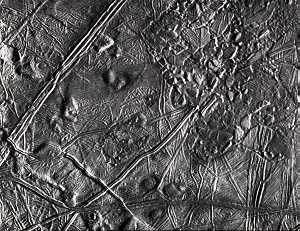An image of Europa's surface, showing many features indicating the presence of a submerged ocean
Click on image for full size
Image courtesy of NASA
Does Europa Have an Ocean?
The surface of Europa shows many signs of that there may be an ocean under the surface:
*
flooded terrain
*
'freckles'
*
rafting
*
'mushy' craters, and
*
spreading centers.
Taken together, these pieces of evidence make it virtually certain that there is an ocean under the icy surface of Europa.
You might also be interested in:
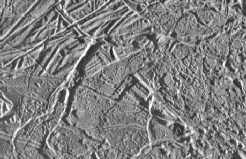
This is an example of terrain of Europa which has been flooded by fresh water which subsequently re-froze on the surface. The edges of the flow are "lobate" meaning rounded like a puddle of water. This
...more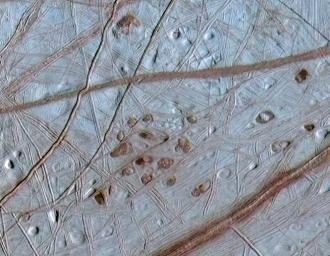
The surface of Europa shows many signs that there may be an ocean submerged under it's icy surface. For example, in this false color picture, the dimples, shown in red, may be a sign of material falling
...more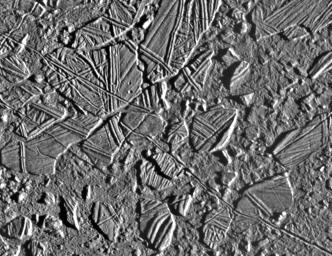
The surface of Europa shows many signs of that there may be a submerged ocean. For example, this picture shows what look like icebergs that may have broken off from a parent block of ice, floated a bit,
...more
Europa was first discovered by Galileo Galilei in 1610, making it one of the Galilean Satellites. Europa is Jupiter's 4th largest moon, 670,900 km from Jupiter. With a diameter that is about half the distance
...more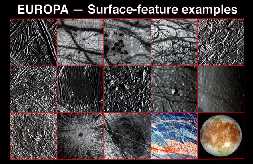
The picture to the left shows examples of the many amazing different surface features of Europa. Many exciting discoveries were made about Europa during the Galileo mission. The surface of Europa is unusual,
...more
The Galileo spacecraft was launched on October 19, 1989. Galileo had two parts: an orbiter and a descent probe that parachuted into Jupiter's atmosphere. Galileo's primary mission was to explore the Jovian
...more
Amalthea was discovered by E Barnard in 1872. Of the 17 moons it is the 3rd closest to Jupiter, with a standoff distance of 181,300 km. Amalthea is about the size of a county or small state, and is just
...more


